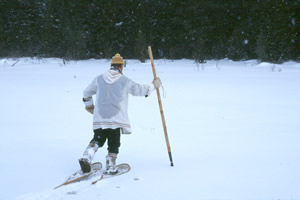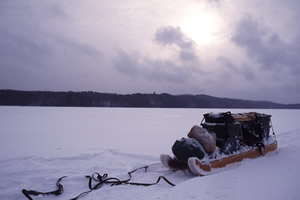Tues Feb. 10 (day 2)
All are up and moving by 6:30am, rolling and stuffing gear. Breakfast is underway. This is not a coffee drinking crowd – my coffee perk on top of the woodstove is ignored by all (except Ken) - I due my duty to empty its contents. A gray and overcast morning, about –5C with strong south west winds blowing at our backs, wet snow falling.
We snake along the banks of the Amable due Fond. Tall bull rushes stick out of the semi frozen crusts – pretty but not the solid ice surface we need to cross. It’s generally flat ground so pulling is easy (loaded weight is estimated to be between 125 and 150 lbs). Eventually, a spot is located and Craig gingerly probes the ice, walking first without a sled. His tracks quickly weep gray slush; I’m dubious about this crossing. We are encouraged to ‘hurry’ – feeling the soft surface bend underfoot, I’m in no mood to linger anyhow.

Its ‘mug up’ and lunch time on shore. A fire is built, the tea pail boils quickly and we dry out sodden mitts, wind anoraks, wet from falling snow and sweat This is to be our noon time tradition and it takes about 2 hours.
North Tea Lake is a large body of water, its frozen expanse stretching until I can’t distinguish gray sky from frozen lake. About 9 km long, its one of the most exposed areas we have to cross. Many places on shore are marked with yellow triangles for summer campsites – winter campers are not permitted to camp in summer sites. Traditional hot winter camping, I discover, is hardly low impact. Small islands, humps of rock with a few trees, pock mark the ocean of white. Thick blowing snow has created white out conditions, I can barely see the lead person yet we must avoid a known section of ‘bad ice’ in some narrows half down North Tea Lake. By staying right along the shore, we safely pass the narrows to the other side and start to look for camp.

Tonight, a site has to be carved out of the bush. Small trees are cleared, so the tent can go up first. I stamp down the snow with my snow shoes, others take axes and look for suitable trees. Bob grabs his chain saw for wood. In about one hour, the tent is up. Then the stove must be set up and the floor ‘brushed’. This involves poking the ends of broken spruce (or hemlock or balsam) tips into the floor to act as a thermo break and insulator from the frigid ground. The ground sheet or tarp goes on top of that, then thermorests and sleeping bags. Personal gear is generally stored outside. Its cozy, warm and smells great. Neil is making spilt pea soup with kielbasa. Lights out by 10pm